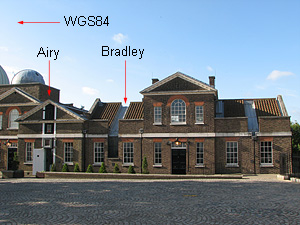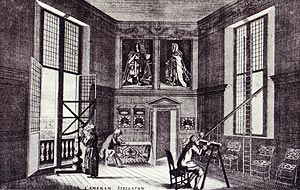The Greenwich Meridian
…where east meets west
The Greenwich Meridian before the Airy Transit Circle
The position of the Greenwich Meridian has been defined by the location of the Airy Transit Circle ever since the first observation was taken with it in 1851. Prior to that, it was defined by a succession of earlier transit instruments, the first of which was acquired by the second Astronomer Royal, Edmond Halley in 1721. It was set up in the extreme north-west corner of the Observatory between Flamsteed House and the Western Summer House. This spot, now subsumed into Flamsteed House, is roughly 43 metres to the west of the Airy Transit Circle, a distance equivalent to roughly 0.15 seconds of time.
On his arrival as the third Astronomer Royal in 1742, James Bradley found the existing instrument to be wanting and commissioned a replacement. This was set up in a new building (now part of the Meridian Building), with the spot where it was erected being located just under six metres to the west of the Airy Transit Circle, a distance equivalent to about 0.02 seconds of time. The new instrument came into use in 1750, defining the Greenwich Meridian from then until 1816, when the sixth Astronomer Royal, John Pond, replaced it with a larger instrument mounted in the same position but on raised piers. The meridian defined by these two telescopes is known as the Bradley Meridian.
 When the Airy Transit Circle came into use in 1851, it became the defining telescope and in the process, the Greenwich Meridian moved nearly six metres to the east. Known also as the Airy Meridian, this was the meridian adopted in principle as the Prime Meridian of the World in 1884.
When the Airy Transit Circle came into use in 1851, it became the defining telescope and in the process, the Greenwich Meridian moved nearly six metres to the east. Known also as the Airy Meridian, this was the meridian adopted in principle as the Prime Meridian of the World in 1884.
The first printed chart or map known to have used Greenwich as its Prime Meridian was published in 1738. The Bradley Meridian not only defined the Zero of longitude for the first Ordnance Survey map published in 1801, but also remains the Zero Meridian used by the Ordnance Survey today.
Since it first opened to the public in 1960, the Observatory has published eight different guidebooks, most in several editions. Surprisingly, there is no consistent view amongst the authors as to which of the instruments, if any, defined the Greenwich Meridian prior to 1721. It was the authors of these various guides who coined the phrases: ‘the first Greenwich Meridian’ (1967), ‘Flamsteed’s Meridian (1970) and ‘Halley’s Meridian’ (1992–93), seemingly in an attempt to both clarify and humanise their narrative. The three terms slipped into common usage without peer review as to either the validity of the concept or as to which, if any, of the various telescopes could or should be regarded as defining them.
The four transit telescopes in their various forms defined not only the Greenwich Meridian but also Greenwich Mean Time, although the Airy Transit Circle ceased to be used for this purpose in 1927. Prior to 1721, the usual way of finding the time (and setting the clocks) was from observations of the midday Sun using the so-called ‘Equal Altitude Method’. These observations were made with a quadrant in the Octagon Room – illustrated below – in Flamsteed House. Because the precise moment at which the Sun crosses the local meridian is difficult to judge, the adopted procedure was to record the time at which it reached a chosen altitude shortly before its highest point at noon and again shortly after. With a small correction to allow for the change in the Sun’s declination between the observations, the time midway between them gave the clock time of apparent noon, from which the error in the clock could be determined.
 So where did the Greenwich Meridian run prior to the erection of the first transit instrument in 1721? When the first Astronomer Royal, John Flamsteed and his peers spoke of the ‘Meridian of Greenwich’, how did they perceive it? The answer perhaps, is as a broad-brush line running through the centre of the Octagon Room, the place where not only time itself was being measured, but also the relative longitude of other places (from timings of satellite eclipses of the planet Jupiter).
So where did the Greenwich Meridian run prior to the erection of the first transit instrument in 1721? When the first Astronomer Royal, John Flamsteed and his peers spoke of the ‘Meridian of Greenwich’, how did they perceive it? The answer perhaps, is as a broad-brush line running through the centre of the Octagon Room, the place where not only time itself was being measured, but also the relative longitude of other places (from timings of satellite eclipses of the planet Jupiter).
Some authors, perhaps because they became fixated with lines that could be stood astride, have stated that one or other of Flamsteed’s Mural instruments, set up in a small building outside, defined the Greenwich Meridian in those early days. There are two good reasons for suggesting this interpretation is incorrect. Firstly, unlike the transit instruments which could be aligned with extreme precision to the meridian, the mural instruments were only ever very nominally aligned. And secondly, although the time difference between the meridian of the Octagon Room and the meridians of the various mural instruments was only a tiny fraction of a second and far too small to measure until modern times, it was the time as ‘nominally’ determined in the Octagon Room rather than on the meridian of the observing instrument itself, that was used for timing the observations.